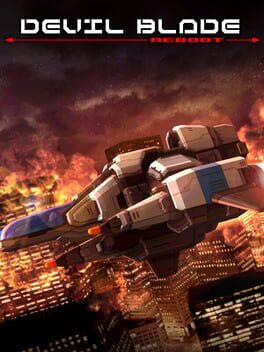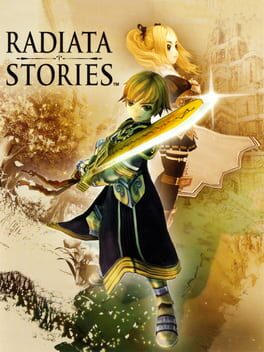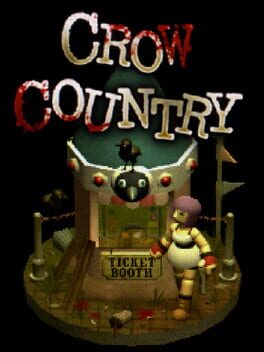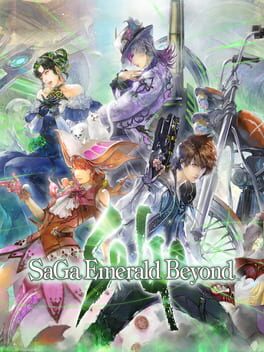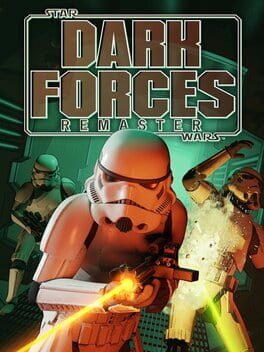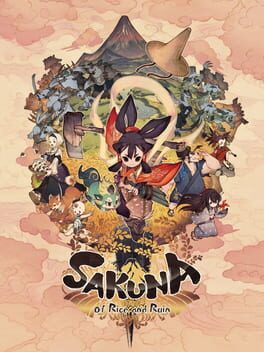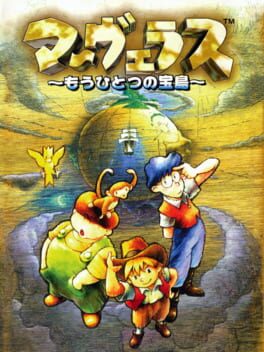spiral
BACKER
43 reviews liked by spiral
Devil Blade Reboot
2024
It goes without saying that this game is gorgeous - a passion project by one of the artists at Vanillaware - so I won't belabor that point. It also has great sounds and music and I loved the empty emotion of text-to-speech saying "I'll see you in hell."
Scoring and survival are pretty standard stuff here. Kill enemies while you're close to them for more points and multiplier, use bombs to survive, and eat bombs to juice your score. What really surprised me, though, was how clever all the patterns were. Most games of this ilk just blindly imitate Cave games - and don't get me wrong, I love Daifukkatsu and ESPrade and Mushihimesama - but Devil Blade is more interested in evoking Treasure shooters with its patterns, in particular Ikaruga. I'm also a huge fan of the scoring system specifically because it means you're constantly nose-to-nose with bosses just ~daring~ them to attack you.
The end result is something gorgeous, fun, and a breath of fresh air for shmups. A great return to form. Really love this. Beat it no-death on Easy already, gonna go for higher difficulties and scores for sure.
Scoring and survival are pretty standard stuff here. Kill enemies while you're close to them for more points and multiplier, use bombs to survive, and eat bombs to juice your score. What really surprised me, though, was how clever all the patterns were. Most games of this ilk just blindly imitate Cave games - and don't get me wrong, I love Daifukkatsu and ESPrade and Mushihimesama - but Devil Blade is more interested in evoking Treasure shooters with its patterns, in particular Ikaruga. I'm also a huge fan of the scoring system specifically because it means you're constantly nose-to-nose with bosses just ~daring~ them to attack you.
The end result is something gorgeous, fun, and a breath of fresh air for shmups. A great return to form. Really love this. Beat it no-death on Easy already, gonna go for higher difficulties and scores for sure.
Radiata Stories
2005
Crow Country
2024
Despite wearing it's influences very openly, Crow Country manages to set itself apart from other survival horror revival projects; mostly due to it's comparably lighthearted nature, the diorama-like presentation, it's peculiar theme park setting, and the overall immaculate pacing. While neither the combat nor the puzzles were especially revolutionary for the genre, the captivating atmosphere and engrossing mystery had me hooked throughout this game's welcomingly modest runtime.
SaGa: Emerald Beyond
2024
I think I just no-lifed SaGa Emerald Byond harder than any game I've ever played before, even as a kid on summer break. Much less as a working adult in my late 30s.
I'll get a few basics out of the way before jumping into my rants on what I like.
This is a budget game. The character models and UI design really show the lack of money. Voice acting is very sparse.
This is not a narrative tour de force. The storylines are schlocky B-movie kitchen-sink nonsense, but, if you like that type of thing, it's very fun and frequently funny. I had an absolute blast with it. I love singing robots and saving molemen and helping plant people bloom, but I can easily see people being put off.
This is not a standard JRPG with dungeons and exploration. You move from event to event on a pop-up book like map, engaging with visual novel type sections or combat. It's a stripped down experience in many ways. As with the narrative, I enjoy this and relish the change of pace, but can easily see how others might not.
Kenji Ito delivered another banger soundtrack. This might be the thing Emerald Beyond has most in common with its higher budget cousins from Square.
With that out of the way, I'll dig into the real meat of what I love about Emerald Beyond. There are two main factors: the combat and the new-game plus cycle.
The combat is absolutely excellent, and sits as my favorite JRPG combat, maybe even surpassing SaGa Scarlet Grace. Much like Scarlet Grace, it's all about timeline manipulation and features a shared action point pool for your party. The specifics of how "united attacks" work has changed and is easier to perform -- for both you and your enemies. More importantly, there's far more variety in your characters -- humans with a ton of weapon types and magic, mechs that scale off equipment and get unique abilities from it, monsters that absorb enemy skills, and ephemerals who get more powerful as they cyclically die and are reborn. The systems are so much fun. Well, except for trading, but I'll circle back to that.
The most mind-blowing thing about the game is its new-game plus structure. There are 5 characters with their own stories and 17 worlds, each also with their own story. All of these stories -- characters and worlds -- can change across successive playthroughs. You can make different choices on who to help, sometimes new options are simply available to you, sometimes you get an entirely different story. Sometimes you recruit entirely different allies. The second playthrough for some characters is almost a sequel to their initial playthrough. It's so cool to see the huge variety in ways things can possible play out as you come back for successive runs. All of the games systems are made to work over multiple 5-20 hour runs, so your overall strength and progress is moving forward even when you restart with a new character.
My biggest complaint about the game is the aforementioned trading system. Essentially, once unlocked, after each and every battle, you have the option to 'sell' items for a random choice from several items, and the option to 'buy' items in fixed deals. These deals are all based on your trading rank, which takes hundreds of trades to level up. The best way to do this is to constantly trade high level weapons for other high level weapons that you then trade for more and so on. It's nothing but tedium, and I don't even have it maxed out after 75 hours of play. The UI is slow, requires a ton of clicks, and is just overall miserable to interact with. Unfortunately, it's the best and most consistent way to get crafting materials, so if you choose to ignore it, you are putting yourself at a huge disadvantage. It wasn't enough to knock the game out of favorite territory for me, but it was extremely annoying and unnecessary -- they could have just tied the trades to your battle rank and had the interface be an option directly at the end of battle screen. I guess it wouldn't be a SaGa game without at least one terrible system, though.
So, uh, rant about trading aside, Emerald Beyond has made its way right to the top of my favorites list. I never enjoy a game for 75 hours and still have plans to come back for more after a break. That just doesn't happen for me. I'm literally considering figuring out of I can mod trading out of the game. Give the demo a try. You'll probably hate it, but you might love it as much as I do.
I'll get a few basics out of the way before jumping into my rants on what I like.
This is a budget game. The character models and UI design really show the lack of money. Voice acting is very sparse.
This is not a narrative tour de force. The storylines are schlocky B-movie kitchen-sink nonsense, but, if you like that type of thing, it's very fun and frequently funny. I had an absolute blast with it. I love singing robots and saving molemen and helping plant people bloom, but I can easily see people being put off.
This is not a standard JRPG with dungeons and exploration. You move from event to event on a pop-up book like map, engaging with visual novel type sections or combat. It's a stripped down experience in many ways. As with the narrative, I enjoy this and relish the change of pace, but can easily see how others might not.
Kenji Ito delivered another banger soundtrack. This might be the thing Emerald Beyond has most in common with its higher budget cousins from Square.
With that out of the way, I'll dig into the real meat of what I love about Emerald Beyond. There are two main factors: the combat and the new-game plus cycle.
The combat is absolutely excellent, and sits as my favorite JRPG combat, maybe even surpassing SaGa Scarlet Grace. Much like Scarlet Grace, it's all about timeline manipulation and features a shared action point pool for your party. The specifics of how "united attacks" work has changed and is easier to perform -- for both you and your enemies. More importantly, there's far more variety in your characters -- humans with a ton of weapon types and magic, mechs that scale off equipment and get unique abilities from it, monsters that absorb enemy skills, and ephemerals who get more powerful as they cyclically die and are reborn. The systems are so much fun. Well, except for trading, but I'll circle back to that.
The most mind-blowing thing about the game is its new-game plus structure. There are 5 characters with their own stories and 17 worlds, each also with their own story. All of these stories -- characters and worlds -- can change across successive playthroughs. You can make different choices on who to help, sometimes new options are simply available to you, sometimes you get an entirely different story. Sometimes you recruit entirely different allies. The second playthrough for some characters is almost a sequel to their initial playthrough. It's so cool to see the huge variety in ways things can possible play out as you come back for successive runs. All of the games systems are made to work over multiple 5-20 hour runs, so your overall strength and progress is moving forward even when you restart with a new character.
My biggest complaint about the game is the aforementioned trading system. Essentially, once unlocked, after each and every battle, you have the option to 'sell' items for a random choice from several items, and the option to 'buy' items in fixed deals. These deals are all based on your trading rank, which takes hundreds of trades to level up. The best way to do this is to constantly trade high level weapons for other high level weapons that you then trade for more and so on. It's nothing but tedium, and I don't even have it maxed out after 75 hours of play. The UI is slow, requires a ton of clicks, and is just overall miserable to interact with. Unfortunately, it's the best and most consistent way to get crafting materials, so if you choose to ignore it, you are putting yourself at a huge disadvantage. It wasn't enough to knock the game out of favorite territory for me, but it was extremely annoying and unnecessary -- they could have just tied the trades to your battle rank and had the interface be an option directly at the end of battle screen. I guess it wouldn't be a SaGa game without at least one terrible system, though.
So, uh, rant about trading aside, Emerald Beyond has made its way right to the top of my favorites list. I never enjoy a game for 75 hours and still have plans to come back for more after a break. That just doesn't happen for me. I'm literally considering figuring out of I can mod trading out of the game. Give the demo a try. You'll probably hate it, but you might love it as much as I do.
To say Treasure went out with a bang is an understatement; this is an absolute high-octane thrill ride packed full of tight action, exciting set pieces, and tough as nails boss battles. Even when this game is beating you to a pulp it always feels fair and finally overcoming obstacles that at one point felt insurmountable is such a rush. Sin & Punishment: Star Successor may very well be the crown jewel of Treasure's catalog and I only wish I had played it sooner.
Nightdive hits it out of the park once again! The last time I beat this game, I had just come home from getting my wisdom teeth pulled and I was all doped up with a mouthful of bloody cotton (it was also 30 years ago). It was nice to get the chance to beat it again in full command of my faculties.
I was pretty impressed this time around at how well the game holds up. It's impossible not to compare it to Doom, and in that regard I think it makes an admirable showing. The enemy and weapon variety and design are pretty weak. Bad guys are basically all hitscanners with various levels of health (in this regard it feels a lot more like Wolf3D), and several of the weapons don't really have a very well defined role. The thermal detonators and land mines in particular seem undercooked to the point of being missed opportunities.
Where the game really shines is in the level design. Here it is enormously helped by the setting and lore. The levels aren't naturalistic, but Star Wars movie sets themselves are rarely naturalistic, opting instead for a strong, unifying aesthetic that's instantly recognizable. It's that aesthetic that the game nails so well and made it feel like a genuinely authentic Star Wars experience.
Dark Forces came out at a really awkward time in the franchise's history. The Extended Universe existed, and there was a fanbase, but LucasArts wasn't really putting the series to work in any meaningful way. I liked the movies and had a bunch of the guys, but I was the only one I knew who was into it at all; the kids at my school thought of it as "old." It was far from a given that a AAA Doom clone in the Star Wars universe would sell, much less start a whole spin-off franchise. My memory is that this was the first 3-D Star Wars experience, and it delivered on that in spades. The authentic sound effects, extremely detailed sprites and beautiful interiors made it more immersive than anything I had seen from this franchise before.
The technical improvements over Doom are very impressive and do a lot to really open up the maps. Moving walls, conveyer belts, rooms over rooms and a handful of true 3-D objects really expand the desingers' toolsets and make for a lot of really great little surprises and help keep things fresh. This time around I did notice a bit more jank than I remember the first time; in particular a few instances of really badly misaligned textures that I thought were pretty disappointing in what was otherwise such a polished experience.
I'm mostly reviewing the original game here because as always Nightdive just nailed the remaster. The uprezzed (?) textures look great, controller play feels fantastic, the new look for the cutscenes is spot on, and the extras are all really interesting. Geezers like myself (and anyone interested in games preservation really) truly are blessed to have these guys doing such diligent, skillful work keeping these old classics alive, and I can't wait to see what they have coming next.
I was pretty impressed this time around at how well the game holds up. It's impossible not to compare it to Doom, and in that regard I think it makes an admirable showing. The enemy and weapon variety and design are pretty weak. Bad guys are basically all hitscanners with various levels of health (in this regard it feels a lot more like Wolf3D), and several of the weapons don't really have a very well defined role. The thermal detonators and land mines in particular seem undercooked to the point of being missed opportunities.
Where the game really shines is in the level design. Here it is enormously helped by the setting and lore. The levels aren't naturalistic, but Star Wars movie sets themselves are rarely naturalistic, opting instead for a strong, unifying aesthetic that's instantly recognizable. It's that aesthetic that the game nails so well and made it feel like a genuinely authentic Star Wars experience.
Dark Forces came out at a really awkward time in the franchise's history. The Extended Universe existed, and there was a fanbase, but LucasArts wasn't really putting the series to work in any meaningful way. I liked the movies and had a bunch of the guys, but I was the only one I knew who was into it at all; the kids at my school thought of it as "old." It was far from a given that a AAA Doom clone in the Star Wars universe would sell, much less start a whole spin-off franchise. My memory is that this was the first 3-D Star Wars experience, and it delivered on that in spades. The authentic sound effects, extremely detailed sprites and beautiful interiors made it more immersive than anything I had seen from this franchise before.
The technical improvements over Doom are very impressive and do a lot to really open up the maps. Moving walls, conveyer belts, rooms over rooms and a handful of true 3-D objects really expand the desingers' toolsets and make for a lot of really great little surprises and help keep things fresh. This time around I did notice a bit more jank than I remember the first time; in particular a few instances of really badly misaligned textures that I thought were pretty disappointing in what was otherwise such a polished experience.
I'm mostly reviewing the original game here because as always Nightdive just nailed the remaster. The uprezzed (?) textures look great, controller play feels fantastic, the new look for the cutscenes is spot on, and the extras are all really interesting. Geezers like myself (and anyone interested in games preservation really) truly are blessed to have these guys doing such diligent, skillful work keeping these old classics alive, and I can't wait to see what they have coming next.
FitXR
2019
Sakuna: Of Rice and Ruin (10/10 title) was incredibly charming in its presentation but man the combat felt super clunky thanks to some of the strange unchangeable controls: a single tap in the direction of an attack to parry, double tap forward to dash (hardly ever used this, so useless), and - the worst offender - double tap R1 to dodge. Right up to the very end of the game it felt like I was half fighting against the controls. You better come to a full stop before you use a quick attack or you're locked into a dash attack that has absolutely no follow-up capabilities and leaves you wide open.
Also why were the directional inputs so unnecessarily sensitive? My controller doesn't have any stick drift yet countless times I found myself locked into an animation facing the wrong way. Early on I hated how little you could do to knocked down enemies (without doing fancy aerial juggling stuff with the raiment) but the game would be so brainless if you could just stun lock everything lol
I probably tried too hard to optimize my rice farming considering you have unlimited years to farm but I suppose that was part of the fun (plus how you avoid overlevelling). Farm sim games probably aren't particularly for me though if they're like this half of Sakuna - it was neat and surprisingly deep but I don't find it relaxing or "comfy" thanks to my silly optimization anxiety (le gamers will optimize the fun out of their games)
The story was fine but the point was definitely the characters - Sakuna herself had a very endearing maturation from her arrogant, lazy brat start and there was a nice "found family" vibe with the farming gang humans. Each member of that gang could have used a tad more fleshing out though (I'd happily sacrifice combat missions for more side stories). That one side quest reveal of Yui's origin shocked the hell out of me lmao (those who know, know)
Oh yeah I played with the English dub and Laura Post was fantastic as Sakuna! Rest of the cast sounded solid too, although I never bothered to compare them all to the JP dub
Also why were the directional inputs so unnecessarily sensitive? My controller doesn't have any stick drift yet countless times I found myself locked into an animation facing the wrong way. Early on I hated how little you could do to knocked down enemies (without doing fancy aerial juggling stuff with the raiment) but the game would be so brainless if you could just stun lock everything lol
I probably tried too hard to optimize my rice farming considering you have unlimited years to farm but I suppose that was part of the fun (plus how you avoid overlevelling). Farm sim games probably aren't particularly for me though if they're like this half of Sakuna - it was neat and surprisingly deep but I don't find it relaxing or "comfy" thanks to my silly optimization anxiety (le gamers will optimize the fun out of their games)
The story was fine but the point was definitely the characters - Sakuna herself had a very endearing maturation from her arrogant, lazy brat start and there was a nice "found family" vibe with the farming gang humans. Each member of that gang could have used a tad more fleshing out though (I'd happily sacrifice combat missions for more side stories). That one side quest reveal of Yui's origin shocked the hell out of me lmao (those who know, know)
Oh yeah I played with the English dub and Laura Post was fantastic as Sakuna! Rest of the cast sounded solid too, although I never bothered to compare them all to the JP dub
Nintendo fans have been waiting years and years for Peach to finally get the spotlight starring in her own console game. It's finally here, and was the wait worth it?
Princess Peach Showtime is overwhelmed with spectacle. So much spectacle which unfortunately leaves little room for substance.
The game is pretty much a Action/Adventure in the most restrictive sense, where I'm almost inclined to call it an on-rails game. Coming from the freedom and fun that was Super Mario Bros Wonder, Princess Peach Showtime is the antithesis of that where your hand is held the whole way through and are forced to partake in scripted segment after scripted segment.
Levels are structured like stage plays, each one having their own genre, where in each one Peach gets a cool transformation to suit the genre of the stage play. Cowboy, Ninja, Chef, Mermaid and much more. At a core level, all stages are 2.5D platformers, but some stages gimmick involve more unique gameplay like cooking or singing.
Showtime's biggest strength is in it's subtitle. The game is filled with glits and glamour. So many cool and amazing looking segments, I could swear the game had a bigger budget than Mario Odyessy. Unfortunately most of these cool segments you find in each stage barely qualifies as gameplay and is more of a cutscene where you are lucky if you're even given the opportunity to press a button.
I honestly feel like this game was targeted towards an even younger audience than the typical Mario game for all ages, which is fair, but honestly Peach deserves better.
One top of all of this, the game somehow runs even worse on the Switch than Tears of the Kingdom did which is baffling considering that this is a much smaller game in scope.
Princess Peach Showtime is one of those games I'll play through once and probably never pick up again. Once you've seen everything spectacular about it, there's no reason to go back and experience again as the gameplay itself barely has anything to offer.
It's still a well made game however... maybe this game was not made for me, but something your younger sibling might enjoy.
Princess Peach Showtime is overwhelmed with spectacle. So much spectacle which unfortunately leaves little room for substance.
The game is pretty much a Action/Adventure in the most restrictive sense, where I'm almost inclined to call it an on-rails game. Coming from the freedom and fun that was Super Mario Bros Wonder, Princess Peach Showtime is the antithesis of that where your hand is held the whole way through and are forced to partake in scripted segment after scripted segment.
Levels are structured like stage plays, each one having their own genre, where in each one Peach gets a cool transformation to suit the genre of the stage play. Cowboy, Ninja, Chef, Mermaid and much more. At a core level, all stages are 2.5D platformers, but some stages gimmick involve more unique gameplay like cooking or singing.
Showtime's biggest strength is in it's subtitle. The game is filled with glits and glamour. So many cool and amazing looking segments, I could swear the game had a bigger budget than Mario Odyessy. Unfortunately most of these cool segments you find in each stage barely qualifies as gameplay and is more of a cutscene where you are lucky if you're even given the opportunity to press a button.
I honestly feel like this game was targeted towards an even younger audience than the typical Mario game for all ages, which is fair, but honestly Peach deserves better.
One top of all of this, the game somehow runs even worse on the Switch than Tears of the Kingdom did which is baffling considering that this is a much smaller game in scope.
Princess Peach Showtime is one of those games I'll play through once and probably never pick up again. Once you've seen everything spectacular about it, there's no reason to go back and experience again as the gameplay itself barely has anything to offer.
It's still a well made game however... maybe this game was not made for me, but something your younger sibling might enjoy.
Best known for being the first directed work of Eiji Aonuma of modern Zelda fame, Marvelous is a really interesting game about a group of boys in a summer camp who get caught in some kind of pirate conspiracy. A very solid SNES/Super Famicom import. Also has a wonderful fan translation.
The puzzles are to be honest, sometimes annoying, especially near the end of the game.
It is made up for in spades though, by sharp, witty writing (which sometimes feels like it shouldn't be in a kid's game. That, or the fan translation took a few liberties.) A beautiful art-style, that while being made in the Link to the Past engine, is far from a copy of that game. The environments are mostly new and creative.
The game's mostly focused on solving puzzles, but you do have a health bar and there is some combat.
I loved the creative use of each of the main characters abilities. The scenarios the characters find themselves in are really creative, as well.
Most of the game is split up episodically. The areas each have their own theme. I won't spoil beyond that, though.
Recommended.
The puzzles are to be honest, sometimes annoying, especially near the end of the game.
It is made up for in spades though, by sharp, witty writing (which sometimes feels like it shouldn't be in a kid's game. That, or the fan translation took a few liberties.) A beautiful art-style, that while being made in the Link to the Past engine, is far from a copy of that game. The environments are mostly new and creative.
The game's mostly focused on solving puzzles, but you do have a health bar and there is some combat.
I loved the creative use of each of the main characters abilities. The scenarios the characters find themselves in are really creative, as well.
Most of the game is split up episodically. The areas each have their own theme. I won't spoil beyond that, though.
Recommended.
